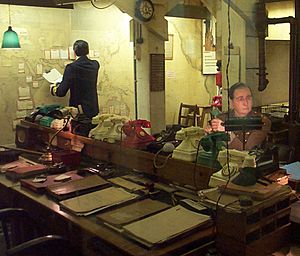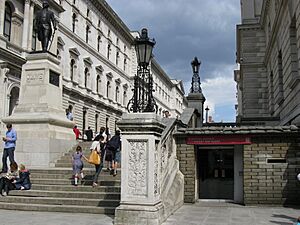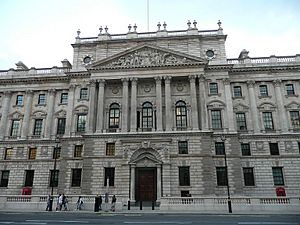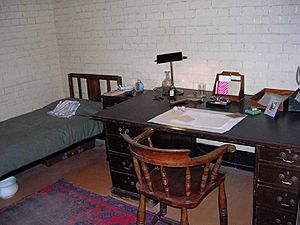Churchill War Rooms facts for kids

The Map Room of the Cabinet War Rooms
|
|
| Lua error in Module:Location_map at line 420: attempt to index field 'wikibase' (a nil value). | |
| Established | 1984 |
|---|---|
| Location | King Charles Street London, SW1 United Kingdom |
| Visitors | 620,933 (2019) |
| Public transit access | |
| Imperial War Museums | |
|
|
The Churchill War Rooms is a special museum in London, England. It's one of five museums that are part of the Imperial War Museum. This museum has two main parts. First, there are the Cabinet War Rooms. This is a secret underground place where the British government led the country during World War II. Second, there's the Churchill Museum. This part tells the amazing story of Winston Churchill, who was Britain's Prime Minister during the war.
Building the Cabinet War Rooms started in 1938. They are hidden deep beneath the Treasury building in Whitehall. These rooms were ready to go on August 27, 1939. This was just one week before Britain declared war on Germany. The War Rooms were used throughout the entire war. They were finally closed in August 1945 after Japan surrendered.
After the war, people realized how important these rooms were. They were kept safe by different government groups. Only a few people could visit them by appointment. In the early 1980s, the Imperial War Museum took over. The Cabinet War Rooms opened to the public in April 1984. In 2005, the museum got a big update and was renamed. Today, it's known simply as the Churchill War Rooms.
Contents
Building the Secret Headquarters
In 1936, the Air Ministry (the part of the British government in charge of the Royal Air Force) was worried. They thought that if war broke out, enemy planes bombing London could hurt up to 200,000 people every week. Because of this, the government started looking for a safe, secret place. They needed a temporary command center in case of air raids.
In March 1938, Sir Hastings Ismay ordered a search for a good spot. They needed a place in Whitehall for an emergency government center. No one had ever built something like this before, so it was a new challenge. In May, as German soldiers gathered near Czechoslovakia, they found the perfect spot. It was the basement of the New Public Offices building. This building is now home to the Treasury.
Work to turn the basement into the War Rooms began in June 1938. Sir Hastings Ismay and Sir Leslie Hollis oversaw the project. They installed special communication systems and broadcasting equipment. They also added soundproofing, ventilation, and extra strong walls. Since the War Rooms are below the level of the River Thames, they put in flood doors and pumps. This was to stop water from getting in.
By summer 1938, military leaders had a new idea. They wanted a Central War Room. This room would help the heads of the army, navy, and air force make important decisions together. The civilian government, especially the Cabinet, needed to be close to these military leaders. So, in May 1939, they decided the Cabinet would meet in this room. With war coming soon, the War Rooms were ready on August 27, 1939. This was just days before Germany invaded Poland.
Life and Work During Wartime
Staff members entered the War Rooms through the main building. They went down a special staircase, coming out near the Churchills' kitchen. Two rooms were super important during the war. The first was the Map Room. It was always busy, 24 hours a day. Officers from the Royal Navy, British army, and Royal Air Force worked there. They created a daily report for the King, the Prime Minister, and military leaders.
The other key room was the Cabinet Room. This is where the Prime Minister and his main advisors met. They also met with the three Chiefs of Staff (the heads of the army, navy, and air force). Secrecy was vital. Two guards stood outside the door during meetings. Sometimes, these meetings lasted until the early morning hours.
Before May 1940, Prime Minister Neville Chamberlain's war cabinet met there only once. But when Winston Churchill became Prime Minister, he visited the Cabinet Room. In May 1940, he famously said, "This is the room from which I will direct the war." In total, 115 Cabinet meetings happened in the War Rooms. The last one was on March 28, 1945. This was when Germany's V-weapon bombing attacks finally stopped.
On October 22, 1940, during the heavy bombing of Britain (called the Blitz), they decided to make the War Rooms even safer. They added a huge layer of concrete called 'the Slab'. This concrete was up to 5 feet (1.5 meters) thick. By spring 1941, the extra protection allowed the War Rooms to grow three times their original size. Many rooms changed their use during the war. But the facility always had dormitories for staff. There were also private bedrooms for military officers and important ministers. Rooms for typists and telephone switchboard operators were also essential.
Two other interesting rooms were the Transatlantic Telephone Room and Churchill's office-bedroom. From 1943, a special secure phone was installed. It allowed Churchill to talk safely with American President Roosevelt in Washington. Their first call was on July 15, 1943. Later, this secure phone was connected to 10 Downing Street and the Transatlantic Telephone Room in the War Rooms.
Churchill's office-bedroom opened on July 27, 1940. It had BBC broadcasting equipment. Churchill made four wartime broadcasts from the War Rooms. The first was on September 11, 1940. Even though it was also a bedroom, Churchill rarely slept underground. He preferred to sleep at 10 Downing Street or a flat above the War Rooms. His daughter, Mary Soames, often slept in the bedroom meant for Mrs. Churchill.
Below the main War Rooms, there was another basement called "the Dock." Staff members could sleep there. This meant they didn't have to go home during heavy air raids. The Dock wasn't very comfortable. The ventilation system was noisy, and mice were common. The ceilings were low, and there were only chemical toilets.
Rooms 60 Right and 60A were used for a telephone switchboard and a typing pool. Because copying machines were very basic back then, up to 11 typists worked at a time. They typed out copies of meeting notes by hand.
After the War: Preserving History
On August 15, 1945, Japan surrendered, ending the war. The next day, the lights in the Map Room were simply turned off. Staff left their offices. Some rooms were cleared and used for other things. But the Cabinet Room, Map Room, Transatlantic Telephone Room, and Churchill's bedroom were saved. They were kept because of their important history.
The Ministry of Works became responsible for their care. In March 1948, people asked if the public could visit the War Rooms. The Minister in charge said it wasn't practical. He explained that the rooms were part of an office where secret work happened. However, a tour for journalists was arranged on March 17. Lord Ismay welcomed them.
Even though the rooms weren't fully open, small groups could visit by appointment. By the 1970s, tens of thousands of people wanted to visit each year. But only about 5,000 were able to. The dry and dusty air was also damaging the furniture, maps, and documents. There was talk of moving everything to another museum. But instead, money was found to protect the items right where they were.
Opening to the Public and New Features

In 1974, the government asked the Imperial War Museum to manage the site. The museum felt it didn't have enough staff or money at the time. But in 1981, Prime Minister Margaret Thatcher, who admired Winston Churchill, hoped the rooms could open soon. The Imperial War Museum was asked again. In January 1982, they agreed to take over. The government promised to provide the money needed.
Prime Minister Thatcher officially opened the rooms to the public on April 4, 1984. Members of Churchill's family and former War Rooms staff attended the ceremony. At first, the museum managed the rooms for the government. In 1989, the Imperial War Museum took full responsibility.
In 2003, the museum got a big expansion. A set of rooms used by Churchill, his wife, and close friends was added. These rooms had been emptied after the war and used for storage. Restoring them cost £7.5 million.
The Churchill Museum Experience
In 2005, the War Rooms were renamed the Churchill Museum and Cabinet War Rooms. A large part of the site (850 square meters) was turned into a museum about Churchill's life. This part cost another £6 million. The museum uses lots of cool video and audio technology. The main attraction is a 15-meter-long interactive table. Visitors can use it to explore digital materials, especially from the Churchill Archives Centre.
The museum tells Churchill's story in different time periods. It starts when he became Prime Minister in 1940. Then it goes to the end of his life in 1965. After that, it jumps back to his childhood and returns to May 1940. The Churchill Museum won the 2006 Council of Europe Museum Prize.
Modern Updates and Visitors
In May 2010, the museum's name was shortened to Churchill War Rooms. Between 2009 and 2011, more than 300,000 people visited the museum each year.
In June 2012, the museum's entrance was redesigned. The new entrance looks like a bronze sculpture. It was meant to be a 'beacon' for the museum. Inside, the old stone walls of the Treasury building were cleaned and restored. The design was described as strong and fitting for the museum's history.
In 2019, the museum welcomed over 600,000 visitors. Like all Imperial War Museum sites, the museum closed to the public from March 17 to July 31, 2020. This was due to the COVID-19 pandemic. It closed again for the same reasons from December 16, 2020, to May 18, 2021.
See also
 In Spanish: Churchill War Rooms para niños
In Spanish: Churchill War Rooms para niños




